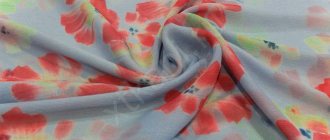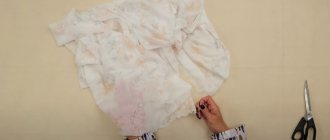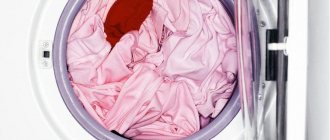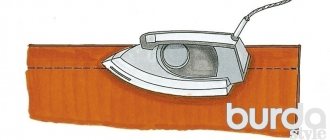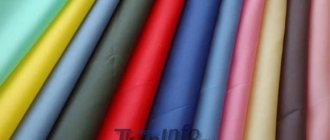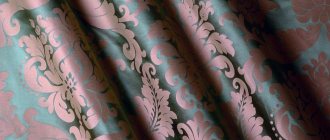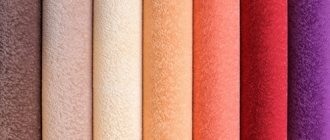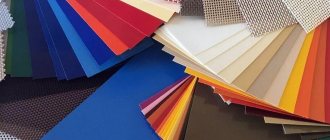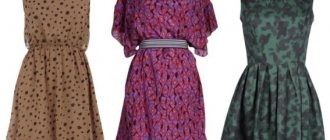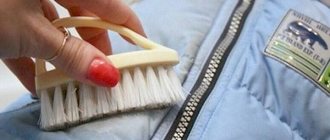DescriptionOrigin
Chiffon is a thin, translucent fabric with a heterogeneous “sandy” texture. It is made from natural animal or plant raw materials, sometimes with the addition of synthetic ones. The surface is slightly rough to the touch, but at the same time very soft and thin. Matter shines through to light.
The rough relief surface is not noticeable to the eye, but is well felt tactilely. Chiffon fabric is one of the most popular and sought-after fabrics for sewing lightweight clothing.
This fabric can be made from silk or cotton. To increase the elasticity of the fabric, viscose is sometimes added to natural raw materials. When creating fabric, silk or cotton threads are tightly twisted and then woven in linen or satin. Increased twisting of the fibers gives the surface a characteristic roughness and strength.
The delicacy and relief of the canvas make this material very pleasant and easy to use. Unlike smooth fabrics, chiffon does not slip and holds well. This property makes the material attractive for sewing light stoles, scarves and capes.
The first samples of this material were found in the East. Initially, chiffon fabric was made from pure silk and was very expensive, so only the wealthiest people could wear it. The fabric came to Europe in the 18th century. It was immediately appreciated by local nobles, who wore luxurious products made from this airy fabric with dignity.
Excursion into history
Historians find it difficult to name not only the year of chiffon’s appearance, but even the century. But no one doubts the homeland of the material, reminiscent of the delicate wings of a butterfly, a thin cobweb. The first to make it were the skilled craftsmen of China. In those days, chiffon clothes were incredibly expensive and were affordable only by noble ladies, representatives of the aristocratic class. The high cost was explained by the manual production method: thin fibers were tightly twisted by hand.
In the 18th century, chiffon became available to European fashionistas. Gradually more and more manufactories appeared. Operations previously performed manually were entrusted to machines. This reduced the cost somewhat. But the fabric was made truly accessible to a wide range of consumers by a technological revolution. The emergence of synthetic fabrics (nylon, polyester, nylon) had a favorable effect on the price, and many varieties with individual characteristics appeared on the specialized market.
The heyday of elegant, flowing fabric occurred during the times of Art Nouveau and Neoclassicism. A.P. Chekhov recalls the chiffon miracle in his story “A Guide for Those Who Want to Get Married.”
“Near-chiffon” debate: synthetic material or natural chiffon?
Once upon a time, silkworm cocoons served as raw materials for making fabric. Today, a composition made from pure silk is rare. Natural fibers increase the cost of the finished textile product and often cause marketing difficulties.
Since 1958, all-polyester chiffon has been on sale. It is more durable and cheaper. But in the specialized market there may also be a mixed material that attracts wear resistance without compromising hygiene.
The best chiffon samples today are produced in China, Romania, and Austria. And you can buy threads for making fabric in India and Russia.
What standards are used in production?
Fabrics made from natural twisted silk (GOST 5618) are produced in accordance with the requirements of this standard and standard technological conditions.
In terms of artistic and aesthetic indicators, fabrics made from natural twisted silk must correspond to standard samples approved in accordance with GOST 15.007.
Determination of the extendability of threads - according to GOST 22730.
Determination of abrasion resistance - according to GOST 18976.
Determination of crease resistance - according to GOST 19204.
Determination of color fastness - according to GOST 7779, GOST 9733.0, GOST 9733.3, GOST 9733.4, GOST 9733.6, GOST 9733.7, GOST 9733.13, GOST 9733.27.
Determination of changes in linear dimensions after wet treatments or dry cleaning - according to GOST 30157.0 and 30157.1.
Read more about the composition of chiffon
The modern textile industry produces noble, flowing fabric from different fibers.
| Thread type | Characteristics of raw materials |
| Natural |
|
| Artificial | The real beauty is viscose chiffon. Viscose, obtained by splitting cellulose fibers with caustic soda, gives the fabric softness, makes it flowy, pleasant to the body and comfortable to wear. |
| Synthetic |
|
During the production process, the threads are intertwined crosswise. This technology provides the sandy structure of chiffon and explains the presence of a barely noticeable mesh, which can only be seen when looking at the material in the sun.
What types of raw materials are used for production
The first chiffon fabrics were woven exclusively from silk fibers. Elite and high-quality material was expensive. Now, several types of raw materials and various combinations of threads are used in production. Combining fibers allows you to improve the quality of the fabric and performance characteristics. Elastane is added to some types of chiffon so that the product can stretch when worn.
The raw materials are:
- natural silk and cotton
Silk fiber is obtained from the cocoon of the silkworm. The soft thread has a triangular cross-section, on which light is refracted and the fabric shimmers. Chiffon with silk threads is very strong, beautiful and elegant. Cotton is of vegetable origin and is specially grown in fields. The cotton plant produces bolls with soft fibers, from which thin and strong threads are spun, with excellent performance characteristics for hot days.
- artificial fiber (viscose)
Viscose is produced artificially by splitting cellulose in a solution of sodium hydroxide. The fiber is durable and soft, comfortable to use.
- synthetic fiber
Polyester refers to polyester fibers that do not tear or wrinkle. Polyamide is obtained from plastic.
Types of fabric
There are different types of material on the textile market: everyday and festive, luxury and budget. They differ in appearance and characteristics. Today you can choose:
| 1. Crepe chiffon | For all its airiness, the fabric is dense and practically not see-through. Characteristic is the special alternation of crepe threads during the weaving process. |
| 2. Satin chiffon. | Combines satin smoothness and chiffon weightlessness. It has a mesmerizing glow of a matte surface. |
| 3. Jacquard chiffon. | Fabric with woven colored patterns provides an embroidered effect. It looks elegant and romantic. |
| 4. Pleated chiffon. | Characterized by smooth, as if sharpened, folds across the entire width. It makes elegant outfits that can periodically be seen on fashion catwalks. Particularly suitable for vintage and retro style clothing. |
| 5. Nylon chiffon. | The main advantages of this type are strength and ease of processing. Does not cause any difficulties with cutting, the edges are not prone to fraying. |
| 6. Double-sided (multi-chiffon). | Has 2 working surfaces. There is no difference between the front and back sides. |
| 7. Shanzhan chiffon. | Additional silk threads are woven into the fabric, softly reflecting light. The result is discreet shimmer. Leopard and spotted prints look especially impressive. |
| 8. Chiffon chameleon. | The composition contains thin threads of silk. It is they who, by refracting the rays, ensure a change in shade from dark to light and vice versa. |
| 9. Pearl chiffon. | Attracts the eye with its pearlescent shine. The charming pearl glow looks especially interesting on dance dresses, in particular ballroom dresses. |
| 10. Sprayed chiffon. | Can be colored, gold, silver. This variety is used to make pop costumes and extravagant evening dresses. Favorite material for designers to experiment with. |
| 11. Chiffon with lurex. | Shiny threads are woven into the fabric. Suitable for creating holiday clothes. Often used to decorate accessories: belts, crossbars. |
As for color, there are no restrictions. Chiffon can be plain (in different shades) or printed. Floral patterns are especially popular. Velvet embossing and gradation are also used, that is, a smooth flow of one tone into another.
Species and types
Crepe chiffon fabrics are dense and translucent, but at the same time unusually light and airy. Chiffon jacquard fabric features a colored pattern woven over a thin base fabric.
Crepe chiffon fabrics
Chiffon made from thin cotton threads can be made with the addition of other threads to give the fabric resistant properties; it practically does not wrinkle, at the same time it is lightweight; in the summer heat, clothes made from such material are simply irreplaceable.
Chiffon made of fine cotton threads
Chiffon chiffon is made using additives from silk threads; initially, silk has a reflective effect, that is, when folded, it darkens, and the second layer is reflected in darker colors. Fabrics of this type with leopard print look great - the fabric plays in the sun with a wide variety of dark-light spots of a leopard shade. You may also be interested in information about how exactly microfiber is used and what it is.
Change chiffon
Chiffon fabric with the effect of silver or gold plating , they were so popular at one time that manufacturers went further; today on the market you can find fabrics with a wide variety of shiny color plating. But what tweed fabric looks like in the photo and where exactly this material is used is described here.
With silver or gold plating effect
With the properties of a chameleon - fabric with the finest silk weave. Under the rays of the sun, walking or moving, the fabric changes its original shade to a darker or lighter one, depending on the intensity of the light. Translucent types of chiffon will only add illusion, so the cost of such material is expensive. But what matting furniture fabric looks like and where else it is used is described in detail here.
Chiffon fabric with chameleon properties
Characteristics of flying material
The popularity of chiffon is explained by its basic characteristics, including:
- Strength. This quality is achieved through the inclusion of cotton and polyester fibers.
- Softness. This is the merit of viscose. The material causes a pleasant tactile sensation.
- Hygroscopicity. Cotton absorbs moisture well, but does not retain it, which allows you to avoid the “greenhouse” effect even in extreme heat.
- Wrinkle resistance. The addition of synthetics makes chiffon fabric not prone to creases and folds.
- Form stability. Even clothes with a complex cut do not stretch or deform. Samples with a high polyester content do not shrink during washing.
- The ability to thermoregulate. During wearing, heat transfer is not disturbed, which ensures comfort.
- Breathability. Air circulates freely between the fibers.
The density of the material is 105 g/m2. meter.
What purposes can this fabric be used for?
Various wardrobe items are made from chiffon:
Skirts
Light casual and elegant formal dresses. Sundresses and summer dresses are indispensable in the heat and give their owners a feeling of soft coolness.
Blouses
Shirts
TOPs
Wide pants
Curtains and drapes
Scarves, capes, pareos and handkerchiefs
All products look decent and serve not only for everyday wear, but also for special occasions.
Why do buyers love translucent chiffon fabric?
Chiffon is associated with celebration, good mood, and comfort. Its advantages include:
- airiness: thanks to the low specific gravity, the outfits are practically not felt on the body. They do not hinder movements or put pressure on the shoulders;
- drapeability: chiffon fits well into folds, soft waves can be formed. This property is especially important when sewing home textiles and clothing of complex styles;
- antibacterial: the fabric does not attract moths and does not rot;
- color fastness: dyes penetrate deep into the structure of the material, so they are not washed out during washing, shades retain their saturation for a long time;
- durability: chiffon is resistant to tearing and abrasion. With proper care it will last for several seasons;
- hypoallergenic: chiffon is safe even for people with hypersensitivity. Especially if the composition is dominated by natural materials.
Chiffon is often called anti-stress textile. Pleasant tactility provides a healing effect: calms, improves tone, improves mood.
Reviews
Galina: For the wedding, I had a stretch chiffon dress made in the studio. It was very comfortable to move actively in it and it practically did not wrinkle.
Alena: In addition to the thick curtains in the living room, we bought chiffon curtains. They turned out to be very light, transmit light well and at the same time hide what is happening in the apartment from prying eyes.
Olya: In the summer I buy several beach tunics so that my look is varied. And these tunics are made of polyester chiffon, which is much cheaper than silk fabric.
Briefly about the disadvantages of chiffon
Despite the huge arsenal of advantages, flowing material is not without its shortcomings:
- Chiffon is difficult to process: it slips when cutting. In addition, due to the fraying edges, large allowances are needed, which increases fabric consumption;
- capricious in care, requires a delicate attitude;
- chiffon is fragile: this applies to fabrics containing viscose, which lose strength when wet. Therefore, you need to use special tools for them. For example, sprays with paraffin or beeswax;
- susceptible to the formation of puffs that spoil the appearance. It is almost impossible to get rid of them; you should be careful and careful when wearing chiffon outfits.
In fact, all these shortcomings can be easily dealt with. And their presence is not a reason to refuse to buy chiffon.
Care instructions
When caring for items made of chiffon fabric, try to follow the recommendations and rules indicated on the labels.
- It is better not to wash silk chiffon yourself, but to take it to the dry cleaner. With the help of special technology, your things will become like new and acquire colors and colors. This way you will save the product and save yourself from unnecessary worries.
- Large items are also best dry cleaned.
- Synthetic material is washed at a temperature not exceeding +30 degrees in a weak soap solution or a special mild detergent composition with the least amount of chemicals.
- When washing, things do not wrinkle, rub or stretch. You need to carefully wash off the greasy stains, and then rinse carefully with warm water.
- Dry chiffon items on special stands or hangers with foam rubber. This way they will retain their shape and last longer. Dresses and blouses are first turned with the lining fabric facing up.
- The fabric dries very quickly, so do not wring it out, otherwise traces of damage will remain. You can dry it in the machine in a special bag, or you can place it between terry towels, and then dry it in the fresh air.
- You need to iron the material with extreme caution: at the minimum setting, without using a steamer or water. Delicate tissue becomes especially sensitive when wet and can be injured by a hot object.
They greet you by their clothes. Your clothes are, first of all, your face. Therefore, a lot depends on its type: status, environment and social connections, public application and much more. Clean, well-groomed clothes always contribute to success. Therefore, taking into account the recommendations of specialists and the characteristics of a particular type of fabric, the service life of the product can be significantly extended. Thanks to proper care, chiffon items will have a beautiful and noble appearance.
To learn how to process the edge of chiffon, see the following video.
Areas of application of chiffon
Noble material is used for different purposes. Chiffon is chosen for making:
- elegant clothes: evening, ball, and wedding dresses look truly luxurious;
- home textiles: light curtains do not prevent the penetration of light into the room, and translucent canopies over cribs look gentle and evoke tenderness;
- accessories: fabric is used to decorate belts, hairpins, brooches.
Also, airy textiles can act as decorative elements - flounces, ruffles, frills.
Description and history
Chiffon is a fabric made from natural, synthetic or artificial fibers. It is light, thin and translucent thanks to the use of tightly twisted threads. In production, plain weaving of warp and weft thread is used, which began to be used in other types of textiles made of viscose and cotton. Chiffon has a slightly sandy texture and a plain or printed pattern.
Like silk, it began to be produced in China. It was intended for noble persons and nobles. The delicate and airy material was worn slowly, with dignity. Chiffon came to European countries only in the 18th century.
Since the middle of the twentieth century, with the development of the textile industry, silk fiber began to be replaced by nylon and polyester. Synthetic threads are durable, easy to obtain and care for. They do not require manual labor or expensive natural resources.
The fabric is used in the manufacture of home textiles, clothing and decorative items.
This is interesting: Textiles for hotels: what to pay attention to, creating an image
Production of chiffon products
Chiffon production volumes are consistently high. It enjoys constant popularity. The fabric is chosen by fashion designers of fashion houses. The collections of Valentino, Kenzo, and Chanel always contain models made of airy, slightly transparent material.
The most popular chiffon items
In any wardrobe there are weightless clothes that can make an image flirty or strict. The best sellers are:
- Women's blouses and dresses, pareos and sundresses. They can be worn daily, worn to formal events, or used for a beach holiday. Emphasize femininity and grace.
- Men's T-shirts, scarves. Modern men also follow fashion and do not shy away from elegant chiffon items that demonstrate good taste.
- Children's outfits. They look cute and elegant. The child feels comfortable in such clothes.
Light vests, cardigans, and stoles can also be made from this material. Chiffon is a good way to add festiveness and brightness to your everyday ensemble.
How to work with chiffon?
All varieties, with the exception of fabrics containing nylon, are difficult to process. To make cutting and sewing easier and to avoid mistakes, you should listen to the advice of experienced craftswomen:
- There are no strict requirements for chiffon when cutting. It can be cut using weft and grain threads. But the pattern must be well fixed on the canvas. To do this, you can use glue strips, special weights, and tailor's pins.
- Fraying edges creates many difficulties. To reduce them, use heated scissors or a rotary cutter.
- For sewing, choose thin threads and needles. Recommended stitch length is 2.5 mm.
- On a sewing machine, seam allowances are sewn with a French stitch or zigzag. On an overlocker - three-thread or four-thread seams.
If, when sewing clothes made of chiffon, it is assumed that there will be a lining, it is better to use woven interlining for this purpose. If desired, it can be replaced with organza. The main thing is that the lining must be carefully ironed.
Advantages and disadvantages
The list of advantages of chiffon materials can be continued for a very long time. Among the most important characteristics for which fashionistas value fabric, we highlight:
- airiness. This is a great option if you are looking for fabric for dresses - you can create light, romantic outfits that no fashionista can pass by;
- good paintability, color fastness. When sewing clothes, you don’t have to limit your imagination; any ideas can be realized. At the same time, for a long time, if used correctly, it will look as if you brought it from the store yesterday (but you should protect the clothes from exposure to direct sunlight);
- durability, tear resistance. It is almost impossible to damage it - stretch, tear, deform;
- softness, drapeability. These parameters make the fabric very convenient for sewing unusual clothing models.
It would be wrong to talk about its advantages and forget about its disadvantages. Most of the disadvantages are due to the fact that the material has a rather delicate structure.
Chiffon fabric is not very convenient to work with, as it is quite slippery, which can cause difficulties during cutting and sewing. In addition, the cut edges of the product are prone to fraying, so additional processing is required. Among other disadvantages, one can highlight the capriciousness of the material in care, its predisposition to the formation of puffs.
Features of caring for chiffon
In order not to spoil chiffon items, be sure to study the label with recommendations. But there are general rules:
- You cannot wash large-size and silk chiffon items yourself. They should be dry cleaned. You need to be careful with viscose. Only gentle hand washing without sharp compression is suitable for her. It is better to use blotting movements. Synthetic varieties can be machine washed in a protective case, choosing a delicate cycle.
- The water temperature for washing should not exceed +30 degrees. It is advisable to use gentle gel detergents.
- Do not squeeze or twist the fabric. Chiffon dries so quickly. You need to let the water drain. The item can be dried between 2 terry towels.
- Drying should be without clothespins. Only on hangers or unfolded. The washed material should not be exposed to direct streams of warm air or sunlight.
- It is allowed to iron chiffon from the inside out using steam or water. You should choose the “silk” or “nylon” mode. Do not touch the soleplate of the iron directly to the surface of the fabric. Ironing can only be done through damp gauze.
Chiffon wardrobe items cannot be stored folded. They must be on a hanger.
Positive and negative characteristics
Beautiful, but capricious fabric has the following advantages:
- Chiffon is soft and delicate.
- It looks attractive and flows softly.
- The clothes are comfortable to wear and do not restrict movement.
- Well ventilated due to breathability.
- It is hygroscopic and has the ability to thermoregulate.
- Due to the ease of dyeing, fabrics are available in many shades and patterns.
- The colors remain bright for a long time, do not fade in the sun and do not fade.
- Thin chiffon drapes well. The folds are beautiful and graceful, which is used when sewing curtains and dresses.
- Chiffon is a hypoallergenic and antibacterial material.
The disadvantages of chiffon are related to the structure of the fabric:
- Causes difficulties when sewing because it slips and warps.
- On untreated cuts, the edge quickly frays.
- The canvas requires delicate handling because it has a low density.
- Chiffon products are difficult to care for.
- Low wear resistance and short service life.
- Silk chiffon fades quickly.
How chiffon is made
The first chiffon fabrics were made in China from thin, tightly twisted silk fibers. It was a very expensive and rare material from which robes were made for the nobility and the imperial court. Chiffon came to Europe only in the 18th century, and was highly valued.
In our time, in the 50s of the 20th century, natural fibers began to be gradually replaced with synthetic ones: nylon, then polyester. The production of such materials was several times cheaper and did not require much labor. They are made using traditional plain weave.
Advantages and disadvantages of the material
Like any material, chiffon has advantages and disadvantages. The main advantages of this fabric include:
- hypoallergenic;
- breathability;
- hygroscopicity;
- ability to maintain body temperature;
- softness and comfort;
- tear resistance;
- drapeability;
- the ability not to lose brightness even after numerous washes.
The following qualities are considered to be the disadvantages of chiffon.
- Difficult to process. This fabric slides and constantly shifts during sewing. In addition, untreated chiffon cuts quickly begin to crumble.
- Low wear resistance. The fabric can fray and become covered with puffs if handled carelessly or as a result of improper washing.
- Sun intolerance. The material may fade if frequently exposed to ultraviolet light.
- Requirement for care. To keep chiffon items looking good for a long time, you will need to put in a lot of effort.
Despite the obvious disadvantages, this fabric does not lose its popularity and is actively used in the creation of various sewing products.
Using chiffon in clothing
Aishwarya Rai at the Cannes Film Festival
Designers are boldly experimenting with chiffon. Clothing models on the catwalks demonstrate the most unusual combinations of chiffon with satin, cotton, denim, linen, knitwear, leather and natural fur. “Flying” fabric is, of course, primarily used to create evening, festive or wedding clothing.
Chiffon is extremely popular among representatives of show business and fashion. In dance, ballroom, and concert costumes, chiffon is present in combination with feathers, rhinestones, embroidery, and furs.
In everyday life, chiffon is used to make blouses, dresses, summer clothes, and lingerie.
Chiffon shawls, scarves, and scarves never go out of fashion.
The best "decoration" for a girl
A gentle girl in a transparent chiffon dress is a dream come true and a popular image in literature and cinema. A dream girl must be in a light transparent outfit, like the heroines of fairy tales.
The popularity of chiffon among women is explained by its softness and ability to easily drape, hiding the “excess” and revealing the beautiful.
The famous fashion historian, writer and part-time popular host of the “Fashionable Sentence” program Alexander Vasiliev is categorical regarding chiffon: “Transparent things should look feminine and sexy, and not defiant and vulgar.”
